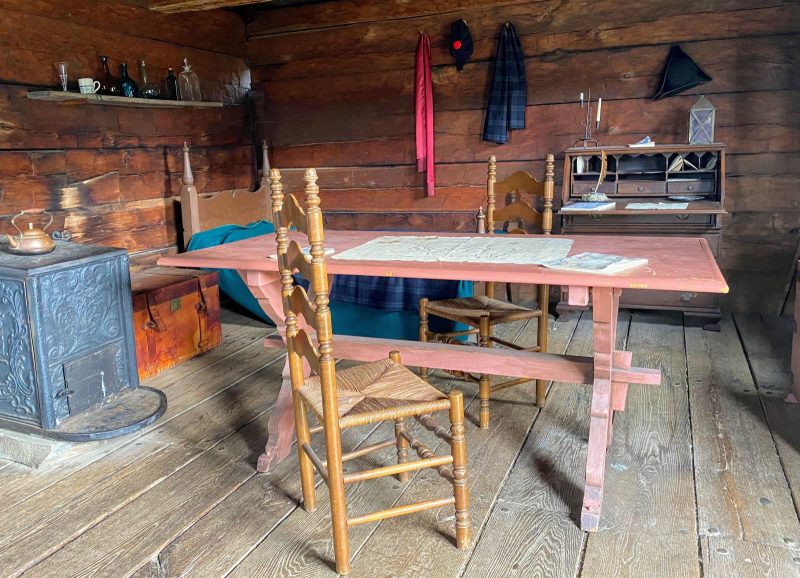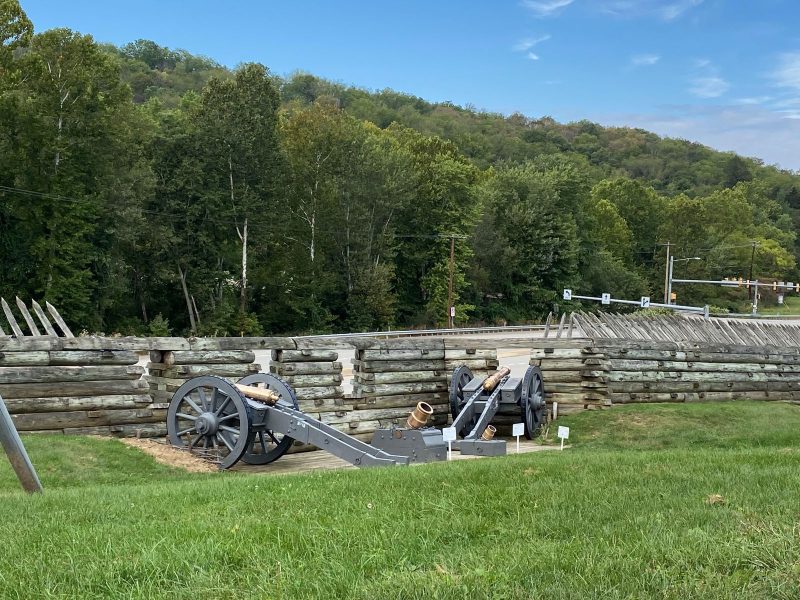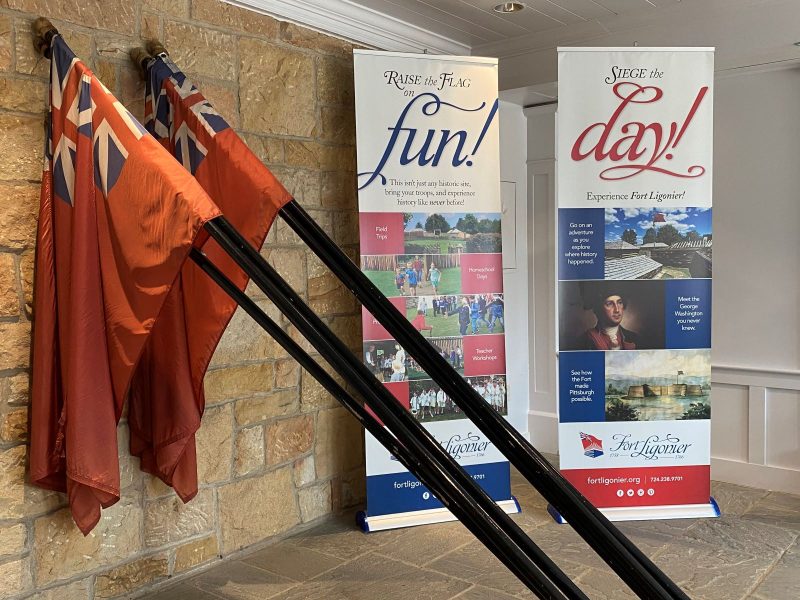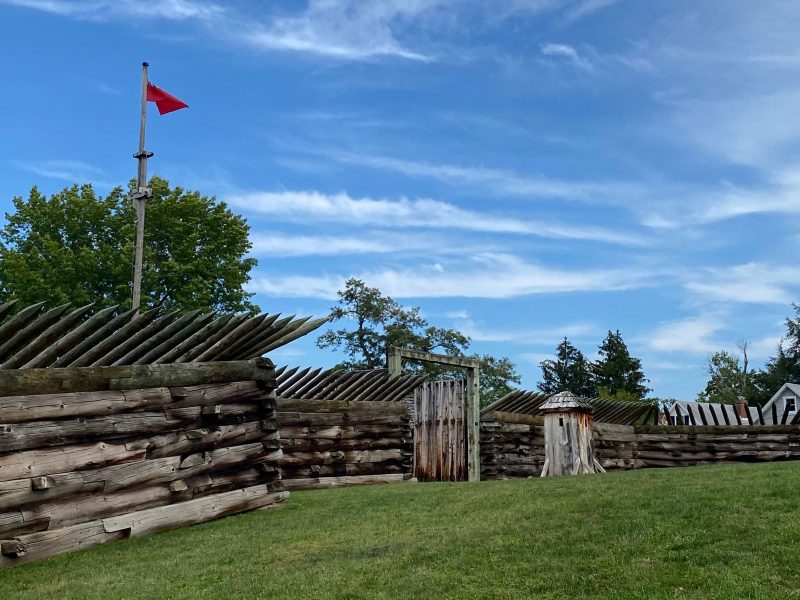Colonial America: Explore Fort Ligonier
This post may contain affiliate links. Click here to see what that means.
Long before Ligonier, PA was the adorable town it is today…. Long before the town square with its gazebo and shops… Long before we were the United States of America… Fort Ligonier staked a British claim for Colonial America on this beautiful, mountainous region in Pennsylvania’s Laurel Highlands.
Table of Contents
Fort Ligonier: A Laurel Highlands Must See
A tour of Fort Ligonier is a “must see” when visiting Ligonier, PA in the Laurel Highlands — and not just for history buffs.
The fort, which I confess was not on my must see list previously, is an incredibly accurate reconstruction of what existed here from 1758-1766, during the time of the French and Indian War.
While I expected just another Early American fort, I found so much more. Fort Ligonier was critical to our nation’s development, during a time when the world was rapidly changing. I am so glad I got to visit — and learn.

A brief history of Colonial America and Fort Ligonier
During the French and Indian War (1754-1763), the British wanted to claim land traveling east to west across Colonial America, including traveling west from the important political city of Philadelphia toward Pittsburgh and its confluence of navigable rivers.
→ Learn More: Historic Boat Tours in Pittsburgh ←
To aid westward expansion, the British built a series of forts along the “Forbes Road” so that troops and supplies could make the long journey toward Pittsburgh, and the French-occupied Fort Duquesne, safely.
Fort Ligonier was the last fort along the road, where troops and supplies gathered in preparation to battle the French to gain control of Fort Duquesne in what is now the Pittsburgh tri-rivers area.

At the same time, the French were building a series of forts stemming south from Quebec toward what is now Louisiana, along the Mississippi River. Their goal, to claim the corridor along the Mississippi from North to South so they could expand out from the river.
Both the British and the French knew that land control equaled power, and both nations wanted the resources that this new frontier offered.
In colonial times, forts were built from available resources — in the Pennsylvania Laurel Highlands, that meant trees!
And, Fort Ligonier is strategically built next to the Loyalhanna Creek (a river), high on a hill with long views of the mountains across the river. There was no way the French would sneak up on them here.
Have you ever thought about these pivotal moments in American history to wonder how different life would be had the French won that war?
Commanding Leadership at Fort Ligonier
The influence of leadership on success is hardly a new concept. In the shaping of the United States, though, many of us — myself included — don’t always know who the great leaders were.
In preparation for my visit, I read a short article on Fort Ligonier, and learned that George Washington played a role. Instantly, I assumed that he was in charge. I was wrong.
→ Visit George Washington’s Mount Vernon: A complete planning guide ←
While George Washington did serve at Fort Ligonier — and made what he considers his greatest military mistake here — he was not in charge. He was a young officer, smart, tenacious and brave. But, he was not the commander in chief. He was just a young officer, under the command of another, working his way up the ladder through hard work.
The real visionary of Fort Ligonier was General John Forbes. Despite being deathly ill — Forbes was so sick he commanded the troops from a litter carried between two horses — Forbes understood how important it was to capture Fort Duquesne. He also was one of the first to understand the importance of working with Native Americans, and not underestimating them.
Ligonier, PA’s commitment to history
Fort Ligonier, built of wooden timbers, was not meant to last. It was a fortification built to serve and protect the Colonial Army — and it did so, from 1758 to 1766.
Over time, land where the fort stood was used for farming by the residents of the Ligonier.
It wasn’t until 1949 that efforts began to restore Fort Ligonier as a historic site and museum.

Ever since, right up to today, archeologists and historians have painstakingly restored the fort on its original footprint. Visitors today can see the fort almost exactly as it stood in the 1760s.
The fort itself requires constant upkeep — like I said, wooden forts weren’t built to last.
Beyond the fort reconstruction, including outbuildings and weapons, Fort Ligonier also has a pretty amazing history museum. One section shares the history of the world side-by-side with Colonial American history. Another section shares the story of the site, including many items found during excavation. There’s also an area dedicated to George Washington, including letters he wrote reflecting on his time at Fort Ligonier.

The Battle at Fort Ligonier
Fort Ligonier would be just another forgotten supply chain depot of Colonial America, except for what happened on October 12, 1758.
French troops from Fort Duquesne came up the mountain on the other side of Loyalhanna Creek, probably a small contingent to see what the British were up to at Fort Ligonier.

General Forbes, sent troops to attack.
It was cold. Fog blanketed the mountain. The British troops did not return as expected.
General Forbes decided to send our good buddy, George Washington, to help out. Washington and his regiment did as they were told, except… Washington made the choice he considers to be his greatest mistake.
It involves the fog.
I won’t tell you more. Go to Fort Ligonier — read about it in his own words.
Anyway… All this happened on October 12, 1758. In the end, the British won, capturing French soldiers who told them the French were abandoning Fort Duquesne.
The British captured Fort Duquesne (not hard when it’s abandoned).
The British also abandoned it — it was prone to flooding — and built nearby Fort Pitt. From then on, westward expansion was possible.
If you have been to this region, you now know how everything named Duquesne, Pitt and Forbes got their names.
Fort Ligonier Days
Since 1960, the town of Ligonier remembers this famous battle during Fort Ligonier Days, a multi-day event held the second week of October every year.
Fort Ligonier Days is a town-wide festival commemorating the October 12, 1758 attack on Fort Ligonier. The fort grounds are filled with historic re-enactments, including all the sights, sounds and smells of 1758. Re-enacters depict the British, French and Native American people who played a role in the attack. The supporting cast, so to speak, is there as well so families can experience this important moment in American history.
Of course, no festival would be complete without fair food, craft vendors and other entertainment that happen throughout town.
Besides all the Fort Ligonier vendors who come to town, Ligonier’s boutique shops and cafes celebrate Ligonier Days as well. While the fort inspired the town’s founding, it’s the locals — the town residents, the locally owned shops and cafes — who brought the fort back to life.
And they know how to celebrate their heritage!
Plan your visit to Fort Ligonier
When visiting the Laurel Highlands, allow half a day to explore Fort Ligonier. Indoor museum exhibits are quite informative. But, the reconstructed Fort Ligonier, built to scale on the grounds where it originally stood, allow visitors to step back in time. It is not hard to imagine what life was like when you see it this way.

The fort and museum are open daily from Spring through Thanksgiving weekend.
- Hours: Hours vary, and can be found at their website or by calling 724-238-9701.
- Admission: Adults, $15, Ages 62+, $12; Kids 4-17, $8, Military, Veterans and Law Enforcement, $8.
- Admission includes all galleries and exhibits in the museum and the fort area. Tours are self-guided, though fort staff and volunteers are available to answer questions.
- ADA Accessibility: Built as an accurate reproduction of the fort as it existed in 1758, Fort Ligonier is not 100% accessible. Museum staff will direct those who need wheelchair assistance to a drop off point at the top of the fort for easier accessibility. While wheelchairs cannot access buildings within the fort grounds, doors are open so that people can look inside. The museum is accessible.
Guided group tours at Fort Ligonier
One of the perks of my job is guided tours of museums, which allow me to learn more about the museum in the little time available for the tour, including a chance to ask questions as I go. Job efficiency, you know?
At Fort Ligonier, anyone can get a guided group tour. Reservations must be made in advance by calling 724-238-9701. Group size and schedule availability are determined by the museum staff.
If you can work it out, I highly recommend taking a guided tour of Fort Ligonier. Their stories bring the history to life, helping you picture what life was really like for the colonial soldiers and their entourage.

On my tour, I stood at the base of the fort, imagining myself carrying a 60 pound pack on my back and having to climb the hill to get inside the fortress walls. Not my idea of awesome adventure, by the way.
The guide showed me the “moat,” explained how the wood keeps rotting and has to be replaced, and helped me understand the mental trauma our Colonial Army faced.
We stood outside the cabin where General John Forbes stayed, and my guide shared the story of his leadership and illness. The cabin sits inside the outer wall of the fort, but outside the inner wall of the fort. In my mind, his cabin location seemed vulnerable — why not have him stay in the inner ring?
First, that inner ring was saved for provisions and ammunition. Without food and weapons, the people would not survive. Essential supplies and weapons were top priority.
Second, I saw his cabin as being on the fringe — the outer edge. But, the guide explained that most of the troops actually lived in tents and rustic cabins beyond the outer wall of the fort. If there was an attack, the French would have to get through all those troops to get to the General, and the troops knew they couldn’t let that happen.
As he explained it, I pictured an American football game and asked, “So, essentially, the troops outside the wall are the offensive line protecting the quarterback, General Forbes?” He chuckled, and said, precisely. (We had talked football already, so this didn’t come out of the blue — exactly.)
Anyway, a group tour at Fort Ligonier gives you the chance to learn more about those things that most interest you. They let history come to life. It’s an incredibly worthwhile experience here.
Learn more about the Laurel Highlands
There’s so much to do in the Laurel Highlands, truly family vacation worthy. Learn more:
